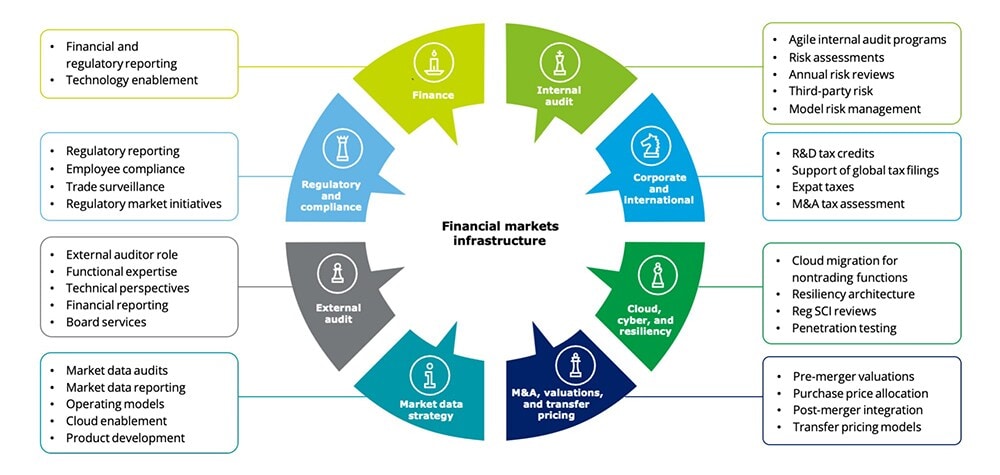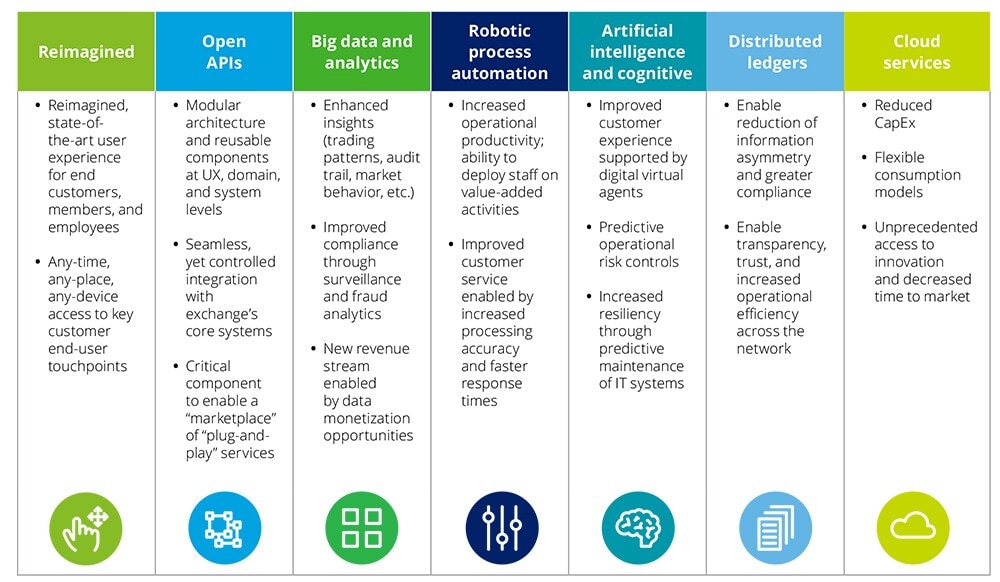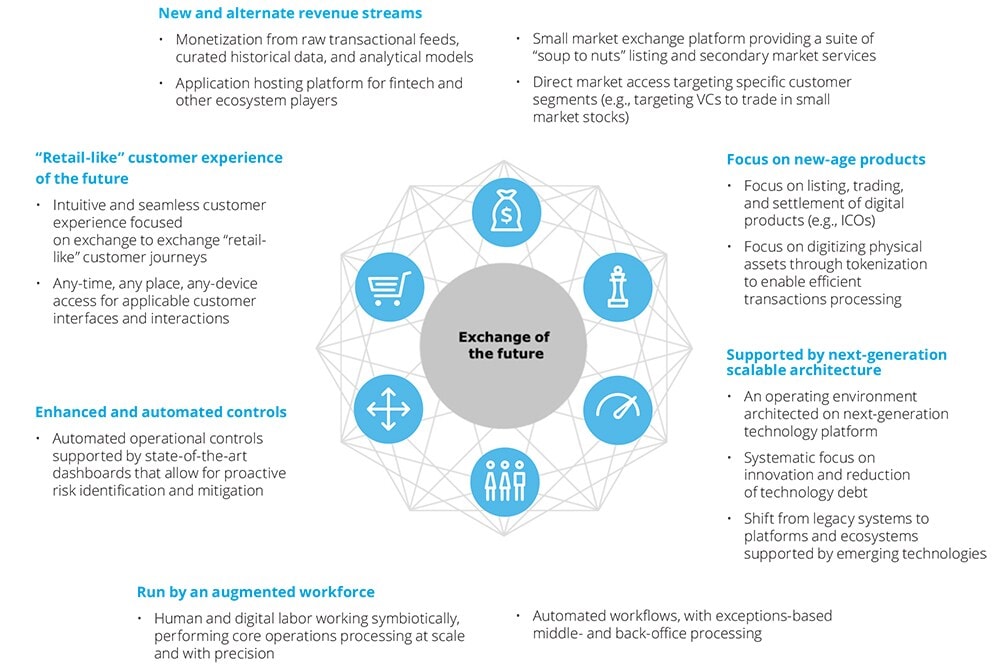The future of global securities exchanges has been saved

Analysis
The future of global securities exchanges
Amplifying the impact of digital transformation in capital markets
Global securities exchanges have much to gain from automating nontrading operations, yet digital improvements in this area are lagging. Our new report explores the factors driving digital transformation in banking, the characteristics and capabilities of the exchange of the future, and guidance on how to get your transformation journey started.
Explore Content
- Takeaways for global securities exchanges
- Drivers of digital transformation in capital markets
- Nontrading exchange operations that could be automated
- The journey to digital transformation
- View the securities exchange of the future
- Moving toward the future-state model of security exchanges
- Bank of 2030: Transform boldly
- Get in touch
- Join the conversation
Takeaways for global securities exchanges
Global futures and securities exchanges have heavily invested and continue to invest in technologies to support high-frequency trading, colocation venues, and direct market access for trading partners. However, digital improvements to nontrading operations are lagging.
Exchanges that automate nontrading operations as part of a larger digital transformation may gain significant benefits, including increased efficiency, a reduced operational footprint, and support for future growth.
Securities exchanges of the future will be characterized by new revenue streams, streamlined operations, and a symbiotic network of ecosystem partners made possible by emerging digital shifts.
Drivers of digital transformation in capital markets
Today there are over 130 global securities exchanges that are trading equities, options, exchange-traded funds (ETFs), futures, swaps, and derivatives for cash, energy, and commodities. All are operating in a banking and capital markets industry being reshaped by business challenges, strategic choices, and the possibilities that emerging technologies offer. Current drivers include:
- Revenue pressures from regulatory mandates and restrictions (for example, fee transparency for market data services and connectivity) and a squeeze on traditional exchange users due to the knock-on effect of quantitative easing; also, tightening margins from increased competition (easy access to new exchanges and products) and lower switching costs driven by technology advancements.
- Exacerbating legacy operational inefficiencies and technology debt as older and traditional exchanges face stiffer competition from new, nimble exchanges.
- Heightened regulatory activity globally, with a particular focus on transparency, oversight, and robust operational controls and risk management processes; scrutiny of operational resilience and risk-spanning surveillance, recovery, and ability to handle stressed markets.
- Constant and evolving cybersecurity threats, requiring laser focus on protecting data and technology ecosystems.
- Significant consolidation of exchanges emanating from technological, legal, and competitive changes and the need to expand into new markets, products, and service offerings.
- An evolving digital ecosystem incorporating blockchain, big data analytics, cloud, artificial intelligence/machine learning, and other emerging technologies.
Nontrading exchange operations that could be automated
As futures and securities exchanges pursue better margins and improved shareholder value, we are seeing evidence of investments in technologies to support high-frequency trading, colocation venues, and direct market access for trading partners. Not keeping pace are digital improvements to exchanges’ nontrading operations; many functions remain dependent on spreadsheets, manually intensive operations, and a limited control environment.
Global securities exchanges that automate these nontrading operations as part of a larger digital transformation may gain significant benefits, including increased efficiency for traditional trading activities, a reduced operational footprint, and support for future growth via alternative mechanisms for revenue generation and an enhanced customer experience.
Securities exchange nontrading operations include these eight areas:

The journey to digital transformation
Over the past few years, some global exchanges have embarked on journeys in digital transformation to reshape their business models, redefine and refresh the customer experience, support new product and service offerings, and strengthen regulatory compliance. Among key focus areas for technology enablement:
- Reduce manual operations. Automate processes through digital interventions across member onboarding, payments, and listings.
- Provide data on demand. Develop models that provide data and information to help clients make efficient trading decisions and better manage capital.
- Reduce latency for various services. Minimize turnaround time for high-volume activities, including risk and regulatory reporting.
- Launch digital products and services. Reduce time to market for blockchain, chatbots, and other offerings.
- Access global exchanges. Partner to provide additional benefits for companies, such as dual listing and increased investor reach.
- Enhance market surveillance. Better identify market manipulation, fraud, and compliance issues with minimal manual intervention.
Digital transformation in capital markets is being enabled by a portfolio of emerging technologies that address current front- and back-end challenges while also making exchanges “future-ready.”

View the securities exchange of the future
The exchange of the future will be characterized by new revenue streams, more efficient operations, and a symbiotic network of ecosystem partners made possible by emerging digital shifts. It will be characterized by:

Moving toward the future-state model of exchanges
In this future-state model, global exchange operators should be well-equipped to engage in numerous initiatives to enhance revenue generation and streamline operations. Potential application areas include IPO listing and continued-listing compliance, securities lending and borrowing, data monetization, small market “storefronts,” complete value-chain coverage for small and mid-sized enterprise institutions, open application programming interface-enabled platforms, shared Know Your Customer compliance, market surveillance, and continuous model validation for clearing and margin.
While the journey to digital transformation in capital markets will not be easy, security exchanges risk being displaced should they not move forward. An important initial step is to answer questions that will guide overall strategy and prioritize functions for modernization.
- Which strengths and capabilities do we have today? Which are core or unique and should be retained? Which do we need to build and/or buy to enable a next-generation exchange?
- How do we eliminate friction points to improve our customer experience—make it more seamless, personal, and intuitive?
- How can we reduce barriers to transacting?
- How can we simplify internal and external processes?
- With whom should we partner to mutualize costs or improve revenues?
Thriving global exchanges of the future likely will be characterized by their understanding and adoption of innovative solutions and enabling technologies that are designed to attract a broader ecosystem of players and provide them with access to more data for decision-making and the ability to access markets seamlessly.
Bank of 2030: Transform boldly
The future of banking will look very different from today. Faced with changing consumer expectations, emerging technologies, and new business models, banks will need to start putting strategies in place now to help them prepare for banking in 2030.
How can you drive bold transformation in your organization over the next 10 years?
Explore Content
- Takeaways for global securities exchanges
- Drivers of digital transformation in capital markets
- Nontrading exchange operations that could be automated
- The journey to digital transformation
- View the securities exchange of the future
- Moving toward the future-state model of security exchanges
- Bank of 2030: Transform boldly
- Get in touch
- Join the conversation

